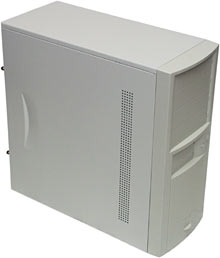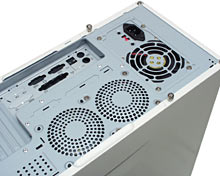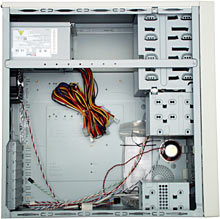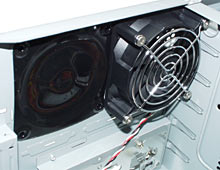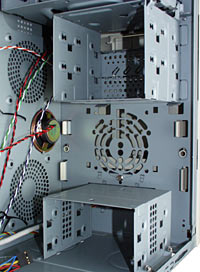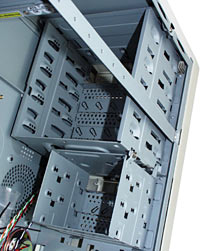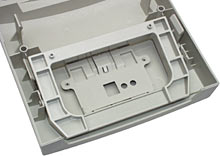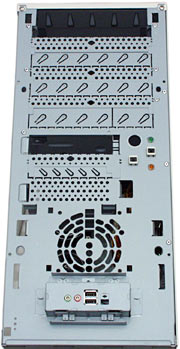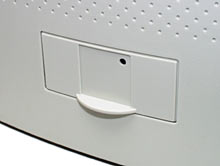
AOpen H600A midi-tower PC case
Review date: 25 September 2001.Last modified 03-Dec-2011.
Let's cut to the chase here. Do you want a Lian Li PC-60 (which I review here), but can't afford it? Maybe you can afford a show-off high-end PC case, but just refuse to spend so large a slab of money on what is, after all, basically just a darn box. In that case, you'll probably find you want this case instead.
Half the price, most of the features, plus some extra bits. Form an orderly stampede.
And now, the long version.
If you don't intend to tinker with your PC, then the case the computer uses doesn't matter much. Most computer users don't even put the machine together themselves, after all. If you're one of these people, there's little reason to use a fancy case.
It's still nice if your PC's case isn't totally crummy, though. Even if you don't intend to lug your computer around a lot, or occasionally use it as an impromptu seat, dirt cheap thin-metal cases have problems. They may buzz as their fans spin, for instance. They may put cards under stress, because the motherboard and card mounting point dimensions aren't quite right. Cheap cases commonly have lousy enough ventilation that hot hardware (in the literal and the figurative sense) won't be happy. And the Power Supply Units (PSUs) that come with el cheapo cases are often highly questionable. A bad or under-powered PSU can cause all sorts of hugely irritating problems that don't obviously have anything to do with power.
But this doesn't mean that undemanding users need to spend a lot of money on a case. Any old case with half-decent build quality and enough bays for all of the drives you want will do. It'll need a PSU that's up to the task of powering your chosen hardware, but any computer assembler will swap a cheap case's standard Spitzsparken Dodgytron PSU for something better if you ask them. OK 300 watt PSUs aren't expensive.
So about $AU130, including delivery, is all most people need to spend on a case.
Which raises the question of why people spend almost $AU400 on a Lian Li PC-60 case that doesn't even come with a power supply.
Two reasons. Pose, and practicality.
The pose part is obvious enough. Lian Li cases are made of aluminium, their manufacturing standards are very high, and everything both looks great and fits together like the panels of a quality automobile. No rattles. No jams. Fake carbon fibre trim that looks like real carbon fibre. Shiny. Shiiiiiiii-nyyyyy.
The Lian Li Web site may be, um, charmingly rustic, but the cases aren't.
The practicality part of the Lian Li purchase decision is obvious as soon as you take the side off one of their cases, big or small. More drive bays than you'd expect from a case of that size, everything easy to access, no sharp edges, tons of ventilation, thumbscrews everywhere so you don't need to use a screwdriver too often.
Let's say you only need the practicality, and can live without the pose. In that case, here's an excellent alternative.
The AOpen H600A is pretty similar to the PC-60, in basic specifications.
The PC-60's large for a midi-tower case, at 210mm wide by 440mm high by 485mm deep (8.25 by 17.75 by 19.25 inches). The H600A's 197 by 455 by 460mm, so you wouldn't notice much of a difference without putting them next to each other.
Pick them up, though, and the difference is obvious enough; the AOpen is the weight you expect an empty computer case to be (9.1 kilograms, or 20 pounds, without PSU), while the aluminium Lian Li is 3.2 kilograms lighter. This difference pretty much vanishes when you've actually built a computer into either case, though. If you're going to be carrying your computer around then it certainly doesn't hurt to save a few kilos in the case, but it's not a difference to get excited about.
In the drive bay count, the AOpen case is only one drive spot behind the PC-60.
The PC-60 has four 5.25 inch bays, all of them with a front panel cutout (so they're "external" bays); the H600A has the same. The PC-60 has six 3.5 inch bays, three of which are external; the H600A has five 3.5 inch bays, two of which are external.
Aus PC Market (Australian buyers can click here to visit the Aus PC site!) were selling the H600A for $AU220, including delivery in the Sydney metropolitan area, when I first put this review up. Now, years later, it's still on sale - for only $AU159.50.
For that price, you get a 300 watt AOpen PSU installed in the H600A. This PSU is a perfectly OK unit for any PC that isn't infested with fans and neon, and it's got an ATX12V connector, for the motherboards that need one.
A PC-60 with the same AOpen PSU will cost you $AU500.50 from Aus PC Market, again including delivery.
So the H600A's definitely cheap compared with the PC-60, but you can still get an OK quality midi-tower case with the same PSU for a lot less than the H600A's price. Why pay the extra?
Glad you asked.
Bells and whistles
The H600A's back panel. There's the usual removable ATX motherboard connector plate (boards with unusual connector layouts come with a plate to match), and separate knock-outs for another couple of USB ports, another DB25 parallel-port-type connector, and a high density SCSI port. Note also the two 80mm fan grilles; more on them in a moment.
The back edge of each side panel has a little pocket-piece that makes the panels easier to slide off. The panels are held on with thumbscrews, which aren't as pretty as the Lian Li ones, but do the job.
Inside, the H600A has a number of nifty features. All of the edges you might cut yourself on are rolled to stop that from happening, and there's a nice solid reinforcing rail that enhances the case's Butt-To-Ground-Adapter value.
The H600A can accept the usual collection of different motherboard form factors - ATX, microATX, FlexATX, Baby AT. ATX boards up to 305 by 244mm (12 by 9.6 inches) will fit. Unlike the PC-60, though, this case doesn't have a slide-out motherboard tray.
Here are the rear fan locations. There's only one fan installed there, by default, but there's no air short-circuit (a fan next to a hole is not a great idea) because the unused fan spot is covered with a shiny black moulded plug.
This one rear fan is the only one you get with the H600A as standard. A PC-60 comes with all three of its case fan spots already filled. Of course, for the money, you'd want it to.
At the front, there are plenty more fan locations. The two bottom 3.5 inch bays are set well forward to leave more room for the motherboard, but that means they occupy the space where most cases have their front fan. So the front 80mm fan spot is higher than usual. The grille for this fan is pretty open - more air than metal - which is a good thing. Real airflow enthusiasts will cut out the grille altogether, of course.
If Massive Ventilation is your goal, you can install two more 80mm fans at the front of this case. The mount points are to the side of the two 3.5 inch drive cages; these fans are meant mainly for drive cooling. The PC speaker sits between the side fan spots, presumably because there wasn't anywhere much else for it to go.
The grilles for the two side fans are flow-restricting lots-of-little-round-holes arrangements. The fans have to draw air through those grilles, and through the five columns of little square holes in the case side as well. So you're not going to get a ton of air flow this way unless you whip out the steel-cutting implement of your choice and knock through some bigger holes.
To be fair, commodity 7200RPM IDE drives are what all vaguely sane PC performance enthusiasts are using at the moment, and they don't need a ton of cooling. Yes, they run warm. No, they don't care. It does no harm to sit them in a howling gale, but the things are made to survive for at least a few years when they're mounted in some awful airless microATX baby-case. A couple of lazy low-RPM 80mm fans to one side of them should be luxury, even if those fans aren't breathing very freely.
All bets are off if you're installing one or more 10,000RPM or higher drives, though. Those all need some airflow, and they cost enough (primarily because they're all still lower-production-run SCSI units, at present) that it's a good idea to protect your investment by giving them a lot of cooling.
Both of the H600A's 3.5 inch drive cages are removable. Two screws retain the bottom two bays, only one retains the top one.
The 5.25 inch bays aren't removable - which is normal - but they do feature what AOpen call "screwless slide in disk drive guides". These are steel rails, included with the case, that attach to the sides of your 5.25 inch drives and let them just click into place in the 5.25 inch bays, and be removed almost as easily.
Behold, the H600A's least compelling feature.
All six of the plastic front bay covers are retained not with the usual double set of click-in latches, but with a single spring clip doodad on the right hand side of the cover. The clip is quite stiff - if cracking macadamia nuts by hand is beyond you, you'll need a screwdriver to pop the covers out.
There's nothing wrong with this clip setup, and it looks sort of technical and interesting, I suppose. And it does let you remove the covers slightly more easily than you can with some poorly designed cases, which make you pop the things out from the other side.
But I doubt this is a job you're going to have to do very often, no matter how enthusiastic a PC tweaker you are, so it really doesn't make much difference.
The H600A's plastic front panel has a neat attachment system. There's a concealed latch-handle at the bottom; poke your fingers in and pull the handle forward, and you disengage the base of the panel. It's then easy to unhook the top of the thing, without any fiddling around inside to undo screws and/or disengage fragile catches.
The latch mechanism's simple enough - it just pushes a couple of catches outwards.
All current Lian Li cases have press-in front panel retainers that work in the same way as the things that hold higher-class speaker grilles onto their boxes. These are quite pleasing, but they'll let go any time you give the front panel a decent tug, and that can happen when you're picking the case up, if you're careless. The H600A front panel is almost as easy to remove when you want to remove it, but it won't budge unless the handle's been pulled.
With the front bezel removed you can see the not-terribly-exciting front of the H600A chassis.
At the bottom of the front panel are two 1/8th inch stereo audio connectors and a couple of USB ports. There's apparently an optional IEEE-1394 (FireWire) connector that can go there as well.
When the front bezel attached, these connectors are covered by this little door...
...which pops in and slides up to reveal them.
As with all cases that sport fancy front connectors - PC-60s on sale now have four front USB ports as standard - you have to plug these things in somewhere if you want to use them.
AOpen wire the H600A USB connectors to a semi-standard connector that you can plug into many motherboards which support extra USB ports, including of course various AOpen boards. Not all motherboards use the same USB-port connector, though; they all seem to use the same basic plug, but there are at least two wiring variations. Each type has a different keying pin blanked off, to stop you from plugging one flavour of port cable into another flavour of motherboard.
The H600A's audio ports are wired to a rather less common connector, which as far as I know you can only use with certain AOpen motherboards. But they're just ordinary analogue audio sockets, so it'd be no big deal for anybody with a soldering iron to rewire them. Connect the sockets to a loop-through cable with 1/8th inch plugs on the end, and you could thread the cable out the back of the case and plug it into your sound card's input and output sockets. Alternatively, you could connect the audio jacks to the standard four-pin CD and AUX connectors on various sound cards and motherboard audio hardware. Those are for input only, though.
Overall
I like this case. It's nice to work with, it's not agonisingly expensive, it doesn't have ridiculous front panel styling that some bored designer in Taiwan thought was really cool, it's got lots of bays, and it's got lots of places to put fans.
If the H600A cost the same as a PC-60, the Lian Li case would be the obvious choice. But the AOpen product is less than half the price of the funky aluminium pretty-boy, and it doesn't have a silver and/or black front panel that looks crummy with ordinary beige drives installed in it.
So if you need a solid, sensible, well thought out midi-tower case, check this one out. Recommended.
Buy one!
Readers from Australia or New Zealand can purchase the AOpen H600A from
Aus PC Market.
Click here!
(if you're NOT from Australia or New Zealand,
Aus PC Market won't deliver to you. If you're in the USA, try a price search
at
DealTime!)
